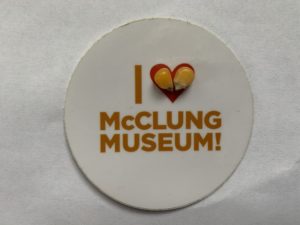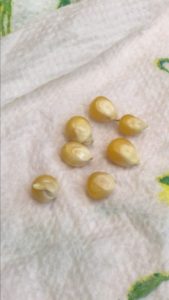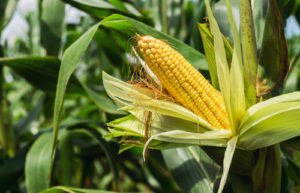
Corn kernels. Some have been chosen from a microwavable popcorn bag.
Welcome to week two of the #SproutChallenge! What seed did you choose for your project? What observations have you recorded? Do you have specific questions for experts at the museum?
The McClung family has been busy contributing to our community garden as well. Peggy Humes, graduate student specializing in paleoethnobotany, works in the museum’s archaeology lab with Dr. Hollenbach. For their #SproutChallenge, both Peggy and Dr. Hollenbach chose corn kernels and have documented their seedling process.

Pre-soaking kernels in a bowl and in a moistened paper towel.

Kernel with radicle.
Notice the white material breaking through the corn kernel. This is called a radicle, the primary root that emerges from the seed during germination. It grows downward into the soil to anchor the seedling. Peggy documented the first appearance of a radicle on day 7 of her experiment.
Corn, or maize, is a fascinating crop! It plays a crucial role in cultures and industries around the world. Maize can produce high yields compared to other crops, and it can be turned into an array of products such as corn flour, cornmeal, hominy, grits, animal feed, ethanol, high-fructose corn syrup, and bio-based plastics. Think of everyday products in your household. They will most likely have a connection to corn. The list is seemingly endless: crayons, chalk, toothpaste, and even diapers!
 Maize has a long and rich history. It was domesticated about 9,000 years ago in southwestern Mexico. Archaeologists find evidence, such as burned corn cobs, indicating humans spread maize throughout the Americas. The dispersal occurred likely through trade networks, with documented evidence from Chile by 3000 years ago to Canada by 1000 years ago. Scholars at the McClung continue to play an important role in unveiling this crop’s a-maizing journey through ongoing research of stored collections, collaborations with local tribes, and gallery exhibitions like the “Archaeology and the Native Peoples of Tennessee.”
Maize has a long and rich history. It was domesticated about 9,000 years ago in southwestern Mexico. Archaeologists find evidence, such as burned corn cobs, indicating humans spread maize throughout the Americas. The dispersal occurred likely through trade networks, with documented evidence from Chile by 3000 years ago to Canada by 1000 years ago. Scholars at the McClung continue to play an important role in unveiling this crop’s a-maizing journey through ongoing research of stored collections, collaborations with local tribes, and gallery exhibitions like the “Archaeology and the Native Peoples of Tennessee.”
Maize plants are passively dependent on humans for their continued survival. The plant requires attention because the seeds don’t disperse by themselves. Archaeological evidence indicates that many native cultures in North America used a companion planting approach to maize production. In this method, maize is planted alongside varieties of beans and squash. The maize stalk provides a physical pole for the bean vines to cling to, the bean plants help increase nitrogen levels of the soil (which foments growth), and squash leaves offer natural shading to hold moisture in the soil. This close relationship is also documented in oral histories such as the story of the Three Sisters, where each sister represents a different crop.
Additional Resources